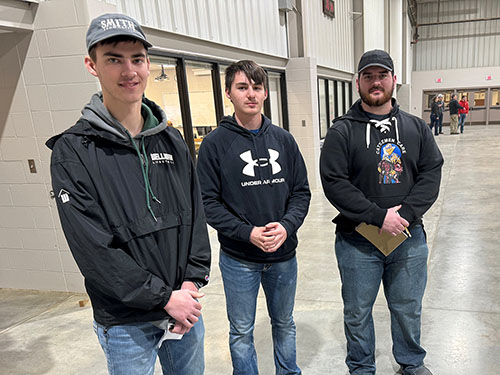It is a competition in which people’s skills are based on the decisions made by “the judge,” another human who is trained and skilled at evaluating livestock.
Unlike athletic competitions determined by scores for such things as touchdowns or goals, competitors in livestock judging earn points based on how closely their choices for placement in a class align with the judge. Contestants also score points based on “reasons,” or telling a judge their reasons for placing a class’s order.
Reasons can be a wildcard or a stabilizer.
A contestant who judges the top goat as the one the judge placed at the bottom can still earn lots of points for justifying his or her choice through reasons. Likewise, someone who picks a class correctly – the same as the judge – can fall short in reasons if it appears their selections were based more on luck than solid reasoning.
Mike Roeber, Northeast livestock judging coach, began the year with eight freshmen on this year’s team. And while teams coached by Roeber have enjoyed success over the years, it isn’t how he measures his team. Seven are still judging as one couldn’t find the time he needed.
Roeber looks for how well the students are growing in their knowledge of livestock and the skills they are acquiring, including being able to look a judge in the eye and recite their reasons without stammering.
And like students who are athletes, livestock students who put in the time to develop their skills improve. That includes practices, where students are judging a variety of classes that might include three animals that are similar and one that is different, or other combinations. Experience helps the student know what to do.
Roeber said some of the students had experience prior to college judging in 4-H or other competitions, but college judging is at another level. One of the biggest things it requires is stamina.
At a major competition like the National Western Livestock Show in Denver, contestants will judge 12 classes and give eight sets of reasons. After a while, things can get blurry.
“You really have to take good notes to get you through the day,” Roeber said. “It could be a class you saw at 8:30 in the morning and then you are giving reasons at 5:30 in the afternoon. Good notes will help you get through the day.”
Additionally, what is determined to be the best market hog or breeding heifer changes over time. College professors, livestock producers, consumers, and others all play an important role in determining what judges are looking for in livestock. Judges keep up with the trends.
Northeast students assisted with putting on the recent FFA district livestock judging contest that Northeast hosted for more than 500 students and 36 schools.
Roeber, who also is an agricultural instructor at Northeast, said the experience behind the scenes also helps the students develop skills. The Northeast students scored the FFA students on their reasons. Some Northeast computer students also assisted with tabulation of points, including sorting cards into the correct stacks.
The more time students spend around livestock judging, whether it is such things as putting classes of animals together, moving the livestock during judging to help competitors get a better look or other jobs -- the more it helps them. It is like an athlete who improves his or her skills by attending camps and helping younger athletes, such as by officiating their contests.
Northeast offers one of three college livestock judging programs in the state. Two of the Northeast livestock judging team members this year competed at the National Western Livestock collegiate judging competition recently.
“They got along fine. They struggled a bit on a couple of classes, but I struggled on a class a bit, too. It’s one of those things. They marked their cards the way I coached them to mark. We just didn’t always agree with the officials that day,” Roeber said.
There are still a lot of competitions left to be tested.
Northeast was to close out January with a competition in Sioux Falls, S.D. February will include competitions in Valentine at the annual Bull Bash and the Cattlemen’s Classic in Kearney. The major competitions include mid-March in Houston and wrapping up the season at the College of Southern Idaho in Twin Falls, Idaho.
“They’re making progress,” Roeber said. “I have two freshmen who came in with quite a few credits and they will be done next fall, so they were the ones I took to Denver. You can see the progression they made so far.”
So compared to past teams, is this team where it needs to be?
“No, but we have had some good reason scores at times. We had some good reason scores in Denver and we had some not so good reason scores. In the average, we are about where we were, but we need more of the good scores. It’s coming.”
Teammates together
Three of the seven members of the Northeast Community College livestock judging team members are shown looking over classes before hearing oral reasons at the district FFA contest. Shown here (from left) are Jack Ritter, Beemer; Kyle Rehak, Wisner; and Cole Miller, Charter Oak, Iowa. Other team members not shown are Grace Meiergerd, West Point; Emily Happold, Doniphan; Tatelyne Snover, Seward; and Kylie Luebbe, Seward. Their coach is Mike Roeber. (Northeast Community College)
###

